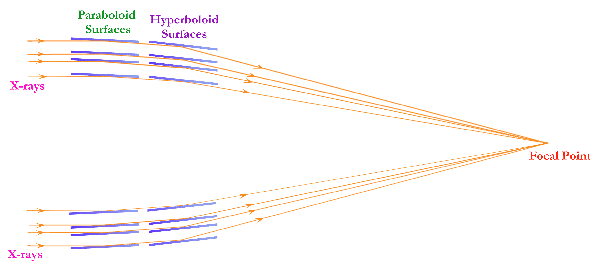
There are two major X-ray Satellites currently in orbit taking data and producing exciting science.
XMM-NEWTON is a European Space Agency mission and was launched on an Ariane V rocket from French Guiana on December 10, 1999.
CHANDRA is a NASA mission and was launched on the Space Shuttle Columbia on 23rd July 1999.
These are the latest in a long line of satellites which have imaged the sky in X-rays and their names might crop up in these web-pages, so here are some of them.
| EINSTEIN | USA | Nov 1978 - Apr 1981 |
| ROSAT | European | Jun 1990 - Feb 1999 |
| ASCA | Japan | Feb 1993 - Jul 2000 |
There are a number of missions which are planned or are in the final stages of completion, and they are reviewed here.
As we have seen X-rays have a tendency to go through materials and as such they are not trivial to focus. They will only bounce off a mirror surface if the incident angle is very shallow. Therefore the mirrors in X-ray telescopes are aligned almost parallel to the incident photon direction. This is known as grazing incidence optics. It is similar to skimming stones over the surface of a pond. If they come in too steep they will break the surface, whereas if the angle is just right they will bounce off.
 |
| Grazing Incidence mirrors, the X-rays arrive at very shallow angles and so bounce off rather than going straight through. (Image courtesy CHANDRA) |
This method has a problem as many mirrors are required as the area they present to the incoming X-rays is actually very small, though they still have a large surface area which needs to be very smooth. Many mirrors are nested inside one-another. It also means that the focal length of the telescope is very long, though combinations of mirrors are used to make this as short as possible.
There are various types of X-ray detectors which work in different ways and are good at telling different things about the source.
X-ray emission from extended sources, e.g. clusters, arises mainly from Thermal Bremsstrahlung (German - "breaking radiation"). This occurs when an electron is deflected from its path by an ion - an atom which has had some or all of its electrons removed and so has a positive charge, attracting the negative electron. This process causes the electron to emit a photon of light. If the electrons have enough energy they will emit X-rays in this process.
X-rays can also be emitted, and absorbed, when electrons are captured by the ion. The new ion/atom then has to get rid of the excess energy which it does so by emitting a photon. This can occur at X-ray wavelengths but also occurs at visible light - Sodium street lights are an example of this type of radiation. Line emission tends to occur at lower X-ray energies.
Another process which affects X-rays is Compton Scattering where free electrons collide with photons (and vice-versa), which causes a change in energy of the electron, and hence the photon, which changes its wavelength as a result. In this case the photons are so energetic they can be treated as particles rather than waves and so interact with the electrons rather like billiard balls.
These processes have all been thermal - i.e. they arise because the gas/plasma is very hot and therefore everything moves fast. In some cases X-rays come from "non-thermal" sources, the electrons move very fast but are not "hot." In a gas which is hot the particles all jostle into one another randomly, and the faster they move the hotter the gas. In a non-thermal source, the particles move very fast but don't jostle into one another. If these particles are charged and move within a magnetic field, then they will emit Synchrotron (or Cyclotron) radiation. This type of radiation spreads over many wavelengths - from the radio to the X-ray.
BACK: What we get from X-rays UP: Introduction to X-ray Astronomy NEXT: XMM-NEWTON